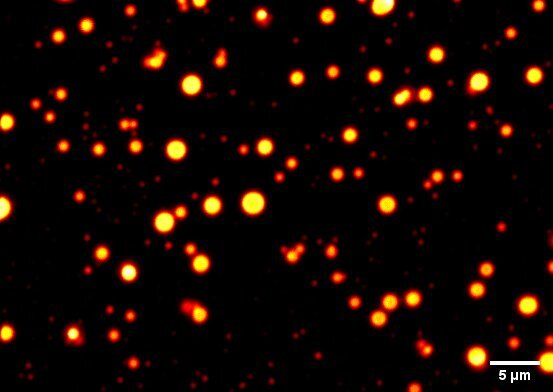RNA’s solo act on the ever-changing stage of cellular dynamics
Rohit Pappu, collaborators find networking afforded by interactions among RNA molecules can enable different phase behavior when heating or cooling

RNA has been in the limelight for its starring role in cutting-edge vaccine technology, but RNA molecules are also key players in the inner workings of cells. Scientists have shown that RNA molecules undergo phase separation to form physically distinct, gel-like condensates.
Co-phase separation of RNA molecules and RNA-binding proteins is known to drive the creation of cellular condensates, which are specialized, membraneless structures that are involved in various cellular processes and have been associated with neurodegenerative disorders. But what about RNA's behavior when it’s a solo act? RNA can also undergo phase transitions in the absence of proteins. However, the fundamental physicochemical forces behind protein-free, RNA-driven phase transitions remain unclear. New collaborative research sheds light on the role of temperature in RNA phase separation, particularly the heating and cooling required to form condensates.
The study, published Nov. 6 in Nature Chemistry, was led by Priya R. Banerjee, associate professor of physics at the State University of New York at Buffalo, in collaboration with Rohit Pappu, the Gene K. Beare Distinguished Professor of biomedical engineering at Washington University in St. Louis, and Venkat Gopalan, professor of chemistry & biochemistry at Ohio State University.
“The phase separation of biomolecules has sort of revolutionized our thinking of how cells compartmentalize processes,” Banerjee said. “Most studies have been protein-centric, with the idea being that proteins form these liquid-like condensates, and we have been very interested in what RNA does to this process. So far, studies have been limited to examining how RNA can regulate protein phase separation, so looking at RNA in more of a regulatory role.”
Banerjee and Gable Wadsworth, a postdoctoral researcher in Banerjee’s lab and first author on the study, became intrigued by how RNA might break out of that regulatory role and phase separate on its own. Through a systematic sleuthing effort, they concluded that all RNA molecules appear to have lower critical solution temperature (LCST) phase behavior, where phase separation is favored at high temperatures. What really surprised them, though, was that polyphosphate, the RNA backbone devoid of the nucleobases and the ribose group, also showed LCST phase behavior.
To get to the bottom of this observed phenomenon, Banerjee and Wadsworth teamed up with Pappu and his group to understand the mechanisms underpinning the behavior.
“We used computations and some of our theoretical understanding of LCST phase behaviors and realized that what Banerjee and colleagues were observing was a combination of two processes,” Pappu said. “The phosphate backbone and the solution ions dissolve with increased temperature. The loss of hydration waters from complementary halves drives RNA molecules to seek one another, and the ions bridge phosphate groups within and across different molecules to enable phase separation.”
As a result, the condensed phases become physically crosslinked networks, and together, Pappu’s and Banerjee’s groups worked out that the networking afforded by strong interactions among RNA molecules can enable different phase behavior when heating or cooling. Notably, the team found that dropping the temperature can lead to persistent condensates. Banerjee's lab also worked with Gopalan’s lab to understand how condensate formation and the interplay between phase separation and percolation impact the functions of an ancient RNA enzyme.
“RNA has this interesting thermometer, if you will, that senses temperature change,” Banerjee said. “This study is a new direction in how we think about phase separation of molecules in general, and could lead to a new understanding of biology, biophysics, materials science and even the origins of life.”
Pappu said he envisions using RNA’s thermoresponsive phase behavior in a range of applications from memory processing and storage to biomaterials.
“The findings in our work, and the apparent designability and tunability of the LCST implies that RNA-based materials for applications of thermoresponsive materials, including for the storage and retrieval of RNA vaccines may well be in the offing,” Pappu said. “Further, most microbes and all plants have to respond directly to changes in temperature, and these changes are likely to influence the phase behaviors of RNA transcripts, thus opening a whole new door in synthetic biology that is based on RNA condensation.”
Wadsworth GM, Zahurancik WJ, Zeng X, Pullara P, Lai LB, Sidharthan V, Pappu RV, Gopalan V, Banerjee PR. RNAs undergo phase transitions with lower critical solution temperatures. Nature Chemistry, Nov. 6, 2023. DOI: https://doi.org/10.1038/s41557-023-01353-4
This work was supported by the National Institute of General Medical Sciences of the National Institutes of Health (R35 GM138186, GM120582), the Air Force Office of Scientific Research (FA9550-20-1-0241), the St. Jude Research Collaborative on Biophysics of RNP granules, and the Henry M. Jackson Foundation for the Advancement of Military Medicine (USUHS subaward 5516).




